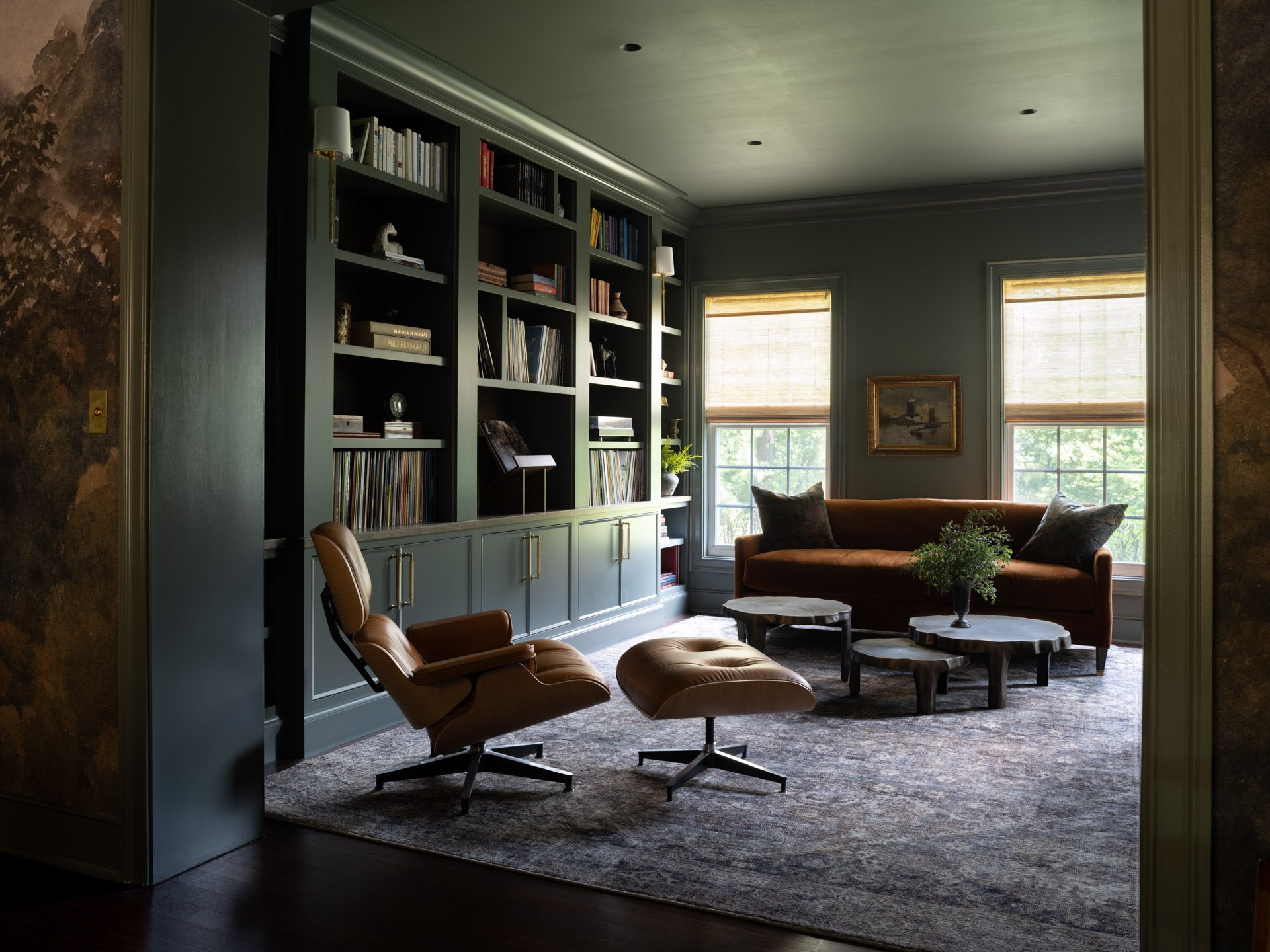
Table of Contents
In the ever-evolving landscape of interior design, a philosophy has emerged that doesn’t speak loudly, but in sophisticated whispers: Quiet Luxury. It’s an approach that resonates deeply with those who appreciate the intrinsic value of exceptional quality, understated elegance, and spaces that nurture comfort and serenity. For the discerning interior designer, understanding and articulating the nuances of Quiet Luxury is becoming increasingly vital. This guide aims to explore the essence of this refined philosophy, offering insights into its principles, its application, and how it can transform a house into a haven of enduring beauty and personal expression for your clients.
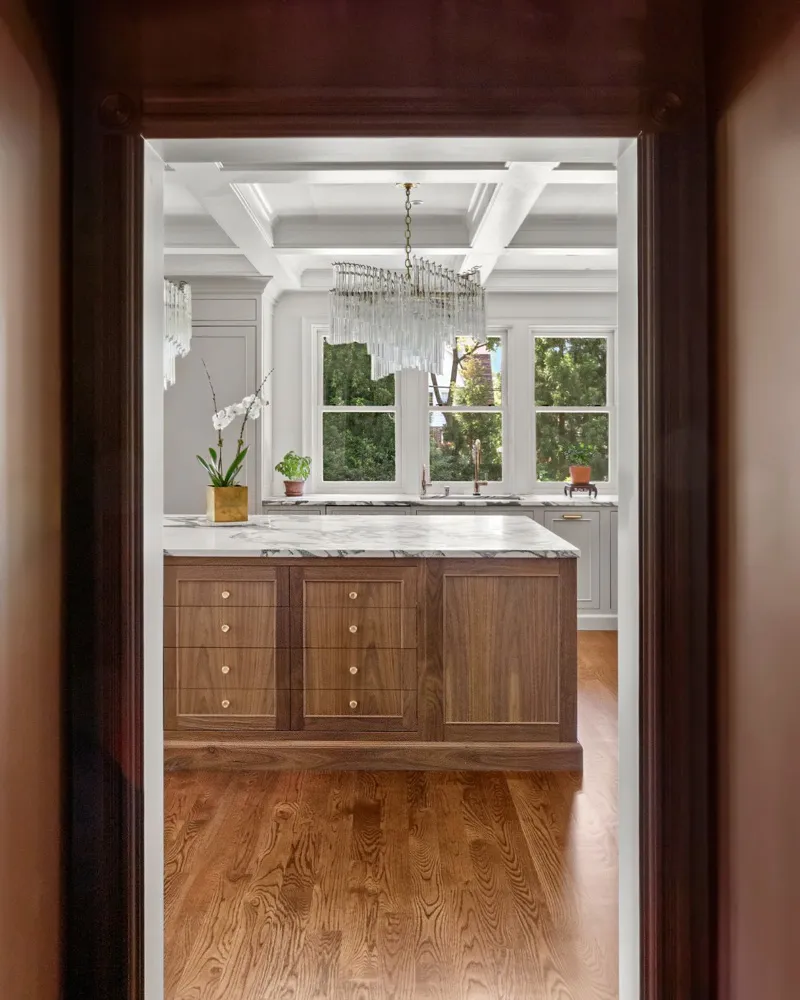
Deconstructing Quiet Luxury: More Than a Trend, A Timeless Approach
Quiet Luxury is far more than a fleeting trend; it’s a considered choice, a philosophy that prioritizes enduring style over momentary fads. It’s about cultivating an environment of understated opulence, where the true value lies in the meticulous craftsmanship, the authenticity of materials, and the profound sense of calm and sophistication that pervades the space. This isn’t luxury that shouts for attention; it’s a confident, serene expression of refined taste. It represents a societal shift, a quiet rebellion against transient displays and overt consumerism, leaning instead towards mindful values, well-being, and sustainability.
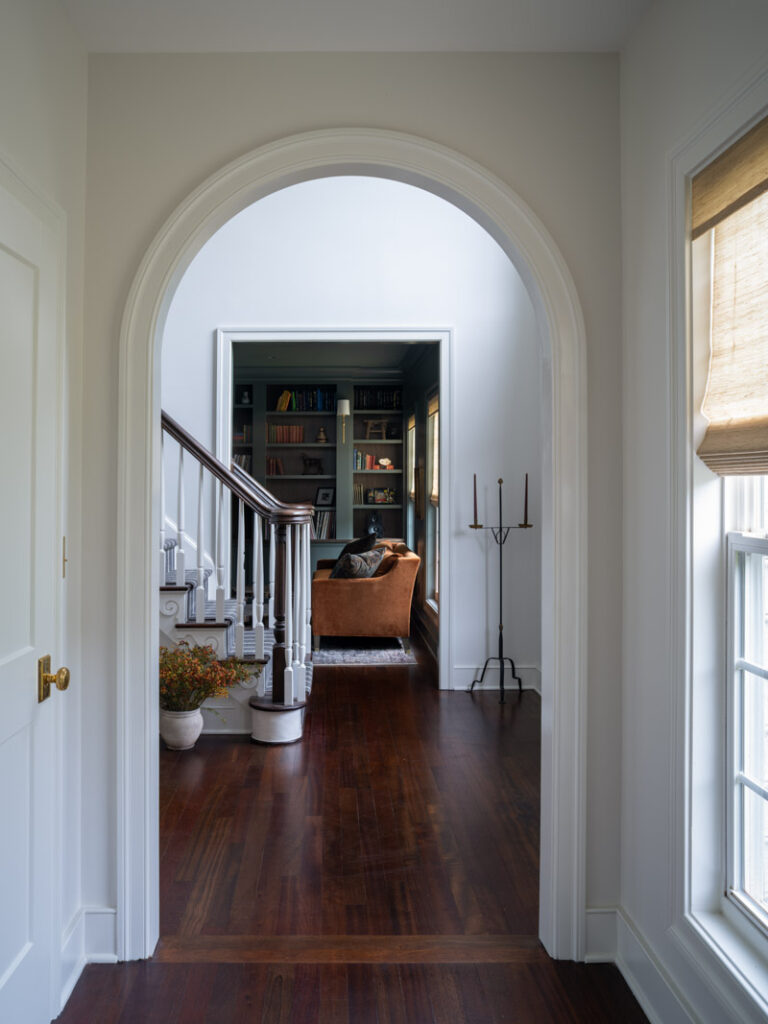
The Core Pillars of Quiet Luxury:
This design ethos is built upon several foundational principles, each contributing to its distinctive and desirable character:
- Exceptional Craftsmanship & Quality Materials: This is the very bedrock of Quiet Luxury. There’s a profound emphasis on superior, often artisanal, skill and the use of genuine, natural materials. Think of the enduring beauty of solid wood like walnut, oak, or mahogany; the timeless elegance of natural stone such as marble (especially with subtle veining), travertine, limestone, or quartzite; and the tactile pleasure of premium textiles like linen, wool, silk, cashmere, or bouclé. These elements are chosen not merely for their visual appeal, but for their durable nature and their capacity to age gracefully, acquiring a rich patina and character over time. It’s a commitment to the time-honored techniques that ensure lasting quality. The hand of the craftsman, the precision in execution – these are the silent hallmarks.
- Timeless Design: Quiet Luxury champions classic silhouettes and design elements that possess an enduring quality. The goal is to create spaces that feel current yet are fundamentally timeless, transcending fleeting trends. This involves a focus on harmonious proportions, balanced compositions, and an aesthetic that feels both elegant and sophisticated. It’s about investing in foundational design principles that will remain relevant and appreciated for generations.
- Considered Color Palettes: Soft, refined, and often muted color schemes are integral. Shades of cream, beige, delicate greys, off-whites, and earthy browns create a tranquil and serene backdrop. These palettes are not about being bland; they are about creating a sophisticated canvas that allows the quality of materials, the play of light, and the subtlety of textures to take precedence, fostering a sense of calm and cohesion. Accents, when used, are often derived from nature or possess an inherent richness, like deep blues or forest greens, applied with restraint.
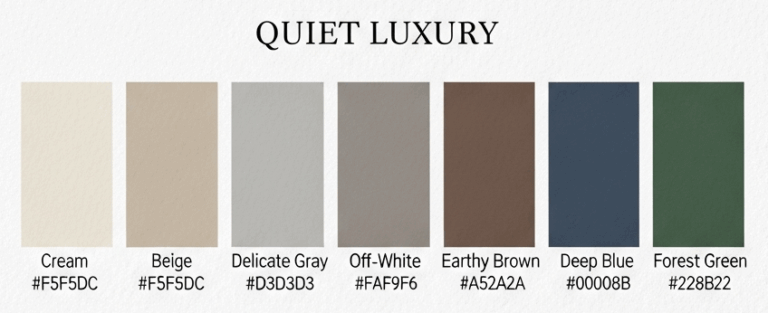
- Minimalism with Warmth: While it often incorporates clean lines, uncluttered spaces, and an appreciation for negative space, the minimalism of Quiet Luxury is far from stark or cold. It’s a tailored approach where every element is carefully curated, beautiful, and functional. This isn’t about emptiness, but about intentionality—reducing visual noise to allow the inherent quality of individual pieces and materials to become the focal point. It’s infused with inviting textures, layered materials, and a palpable sense of warmth, ensuring spaces feel welcoming and livable.
- Subtle Sophistication & Meticulous Attention to Detail: The magic of Quiet Luxury often lies in the details – the precision of joinery in custom cabinetry, the quality of a hand-applied finish, the way different materials meet and transition, the considered choice of an edge profile. It’s a meticulous approach where every nuance is considered, contributing to an overall feeling of refined elegance. These are not details that scream for attention but are discovered and appreciated over time, revealing the depth of thought in the design.
- Comfort and Functionality: Beyond its aesthetic appeal, a Quiet Luxury space is designed to be lived in. Comfort is paramount, and functionality is seamlessly woven into the design, enhancing the ease and pleasure of daily life. It’s about creating functional beauty, where elegance and practicality coexist effortlessly. Furniture is chosen for its ergonomic support as much as its form; layouts are intuitive and promote a natural flow.
- Personalization & A Lived-In Feel: This philosophy encourages the incorporation of unique, personal items that tell a story or hold sentimental value – cherished books, art collected on travels, family heirlooms, meaningful photographs. These elements add depth, personality, and an authentic, curated living experience, making the space truly reflective of the inhabitants’ lives and values. This “lived-in” aspect, however, is a result of deliberate curation, not accidental clutter, ensuring it enhances rather than detracts from the overall sophistication.
Distinguishing Quiet Luxury:
It’s crucial for designers to articulate how Quiet Luxury diverges from other aesthetics:
- Quiet Luxury Versus Stark Minimalism: While both share an affinity for clean lines and uncluttered spaces, Quiet Luxury distinguishes itself through its inherent warmth and layered complexity. It incorporates lush, thoughtfully chosen materials and textures, creating an inviting, tactile environment. Traditional minimalism, in its starker forms, can sometimes feel austere; Quiet Luxury is indulgent in its quality and sensory richness.
- Quiet Luxury Versus Maximalism: Maximalism, with its bold embrace of pattern, color, and exuberant personal expression, stands in direct contrast to Quiet Luxury’s understated and serene ethos. Where maximalism shouts exuberantly, Quiet Luxury whispers contentment.
- Quiet Luxury Versus Ostentatious/Flashy Luxury: Quiet Luxury consciously avoids “flashy or overtly branded items” and rejects “bold and flashy aesthetics.” It represents a deliberate move away from conspicuous displays of wealth, focusing instead on intrinsic value, superior craftsmanship, and profound personal comfort. It doesn’t rely on logos for validation, and therefore, logos may be found in more inconspicuous places.

The Interior Designer's Compass: Navigating Quiet Luxury
As interior designers, you are often the translators of aspiration, guiding clients toward spaces that not only look beautiful but also feel deeply right. Quiet Luxury, with its nuanced language, presents both an opportunity and a delightful challenge. Here, we address some pivotal questions that arise when implementing this sophisticated style.
Q1: How can the core essence of Quiet Luxury be effectively defined and communicated to clients who might traditionally expect more overt displays of wealth?
Communicating the value of Quiet Luxury requires shifting the conversation from visible expense to intrinsic worth. Emphasize that this style is about an “understated opulence where elements of design are carefully curated and serve a purpose.” It’s a philosophy that prioritizes “simplicity (and quality) over more overt displays of wealth,” focusing on creating an “exclusive and intimate” ambiance without being flashy.
- Use Eloquent Language: Phrases like “elegance that whispers rather than shouts” can be powerful. Highlight the inherent value of “timeless materials,” “impeccable craftsmanship,” and a sense of “calm confidence.”
- Frame it as an Investment: Position Quiet Luxury as a long-term investment in enduring quality and a deeply personalized sanctuary that reflects sophisticated taste rather than transient status symbols. Explain that these are spaces built to last, both in style and substance.
- Focus on the Experience: Describe the feeling of living in such a space – the serenity, the comfort, the quiet satisfaction derived from being surrounded by authentic quality.
- Educate on Craftsmanship: Share stories about the artisans or the meticulous processes behind key pieces. When a client understands the skill and dedication involved, the value becomes more tangible.
Q2: Beyond neutral palettes, what are the truly distinguishing material and textural choices that define a Quiet Luxury interior?
While neutral palettes form the serene backdrop, the soul of Quiet Luxury lies in its premium materials and the rich tactile experiences they offer.
- Solid Woods: Champion woods like walnut for its deep, rich tones; oak (especially white oak) for its linear clarity or classic warmth; mahogany for its traditional elegance; and maple or cherry for their fine grain and finishing capabilities. The natural grain patterns are celebrated, often enhanced by subtle stains or clear matte finishes.
- Natural Stones: Specify marbles with subtle, elegant veining (Calacatta Gold, Carrara); durable and beautiful quartzites; textured limestones and travertines that add warmth and history. Honed or matte finishes are often preferred over high polish to enhance the stone’s natural character.
- High-Quality Textiles: Layer spaces with linen for its relaxed elegance, wool for its warmth and durability, silk for its subtle sheen, cashmere for ultimate softness, and bouclé for its inviting texture. These are used in upholstery, drapery, throws, and rugs.
- Finishes with Depth: Move beyond basic paint. Consider hand-applied plaster for walls, lime wash for a soft, breathable finish, or traditional techniques like cerusing on wood to highlight the grain. For cabinetry and furniture, matte or low-sheen finishes are paramount, avoiding anything overly reflective.
- Subtle Textural Plays: Texture is introduced through the weave of fabrics, the natural finish of stone, brushed metals (like aged brass or matte black), fluted wood details, or even the subtle texture of handmade ceramic tiles. The interplay of these textures creates a rich, sensory environment that is a hallmark of the style. The tactile experience is central – it’s about how materials feel as much as how they look.
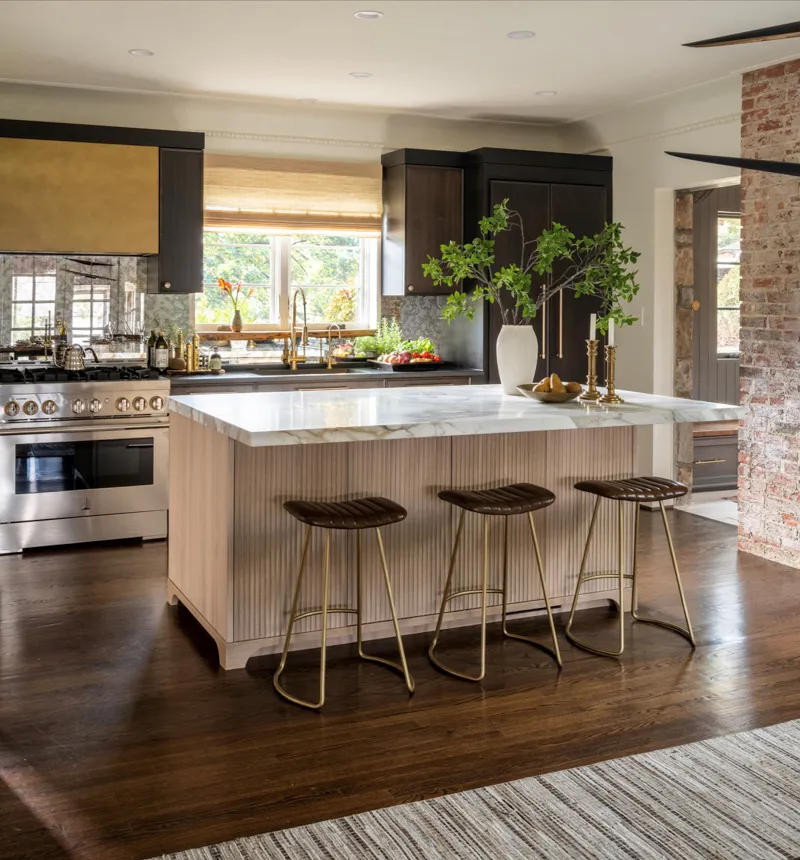
Q3: What are the common challenges designers face when implementing Quiet Luxury, particularly concerning client expectations, budget management, and sourcing unique pieces?
Implementing Quiet Luxury beautifully requires navigating several practical considerations:
- Managing Client Expectations: As discussed, if clients equate luxury with overt displays, education is key. Show, don’t just tell – use material samples, visit showrooms, and present portfolio examples that embody subtle refinement. At Master Design Cabinetry’s showroom and discovery room, there are many samples and designs your client can see and touch.
- Budget Justification: High-quality materials and bespoke craftsmanship often come with a significant investment. Designers must be adept at articulating the long-term value, durability, and unique character that these choices bring. Break down costs transparently and explain the “why” behind premium selections.
- Sourcing Unique Pieces: Quiet Luxury often relies on pieces that aren’t mass-produced. This can involve sourcing from individual artisans, seeking out vintage markets, or commissioning custom furniture and cabinetry. This requires a strong network, patience (lead times can be longer), and robust project management to handle the “perils of procurement.”
- The “Invisible” Value: The most significant challenge can be articulating the value of what’s not immediately seen – the quality of internal construction in cabinetry, the hours of hand-finishing, the ethical sourcing of materials. This requires storytelling and building trust. This is exactly what Master Design Cabinetry is about and we are happy to support you in the work you do for your clients.
Q4: How does Quiet Luxury align with contemporary values like sustainability and well-being, and how can these aspects be effectively leveraged in design proposals?
Quiet Luxury inherently champions both sustainability and well-being, making it highly relevant to contemporary client concerns.
Sustainability:
- Durability & Timelessness: Choosing high-quality, durable materials and timeless designs naturally promotes a “reduce-and-reuse” philosophy, moving away from fast-fashion furniture.
- Natural Materials: Prioritizing natural, renewable, and often locally sourced materials (wood from managed forests, natural stone) reduces environmental impact.
- Ethical Craftsmanship: Supporting local artisans and ethical workshops contributes to sustainable livelihoods and often involves more environmentally conscious practices.
- Leveraging: Highlight these aspects in proposals. Discuss the longevity of the chosen pieces, the origin of materials, and the stories of the craftspeople. Frame it as a responsible luxury.
Well-being:
- Calm & Serene Environments: The neutral palettes, uncluttered spaces, and focus on natural light create soothing atmospheres ideal for relaxation and reflection.
- Natural Materials & Biophilia: Incorporating natural materials and elements of biophilic design (plants, views of nature, organic patterns) has been shown to reduce stress and enhance overall health.
- Non-Toxic Environments: Specifying low-VOC paints, natural fibers, and materials without harmful chemicals contributes to healthier indoor air quality.
- Leveraging: Explain how the design choices directly contribute to a healthier, more peaceful, and restorative home environment. Connect the aesthetic to tangible benefits for the client’s daily life.
The “whisper” of Quiet Luxury needs to be translated by the designer into a compelling narrative that explains why this subtle, thoughtful approach is ultimately more sophisticated, rewarding, and aligned with modern values.
The Enduring Allure: Why Quiet Luxury Captivates the Discerning Client
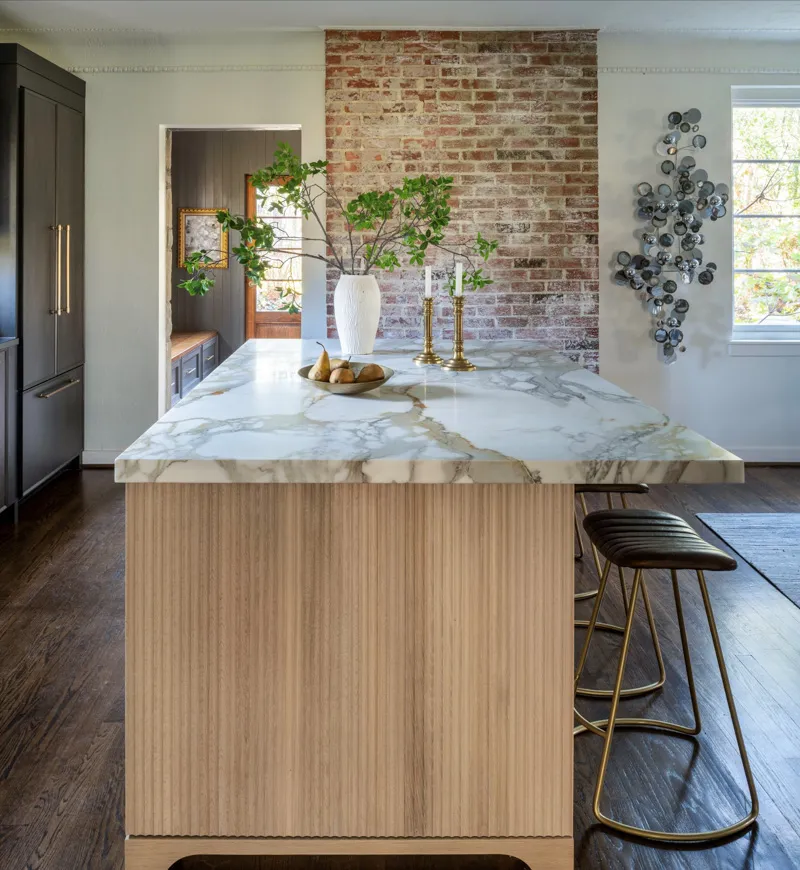
The appeal of Quiet Luxury to discerning clients is multifaceted, touching upon deep psychological desires for comfort and authenticity, a pragmatic appreciation for timeless value, and an increasing alignment with ethical considerations.
- Psychological Drivers: Comfort, Authenticity, Serenity, and Sophistication:
In an increasingly fast-paced and often chaotic world, Quiet Luxury offers a “refuge”—an environment that nurtures, calms, and restores. It mirrors a broader societal shift towards “intentional living, where comfort, authenticity, and longevity matter more than passing fads.” The emphasis on natural materials and calm color palettes is not merely aesthetic; it demonstrably aids in relaxation and contributes to overall well-being. Furthermore, the encouragement of a “lived-in look” through the thoughtful display of personal items caters to a fundamental human need for self-expression and environments that tell a unique story. This transforms a house into a deeply personal home. - Timelessness vs. Trend: Investing in Enduring Style:
A significant draw for clients is Quiet Luxury’s promise of enduring style. It is consistently positioned as a design approach that “will not go out of style,” primarily due to its reliance on “classic materials and designs.” This philosophy encourages “investing in high-quality, timeless pieces,” ensuring that homes remain both stylish and functional for many years to come, representing a prudent and sophisticated approach to consumption. Clients are increasingly drawn to making lasting investments, moving away from the cycle of frequent redecoration driven by ephemeral trends. - Sustainability and Ethical Considerations as Value Drivers:
The principles of Quiet Luxury inherently align with growing concerns for sustainability and ethical production. The choice of “durable materials and timeless designs” naturally fosters a “reduce-and-reuse philosophy.” The ethos often involves sourcing from “local artisans” and supporting “ethical craftsmanship,” adding a layer of social responsibility. For discerning clients, these ethical and sustainable dimensions add significant value, allowing them to align their home environment with their broader personal values. - Sophisticated Status: The “Stealth Wealth” Appeal:
Quiet Luxury can also be understood as an expression of “stealth wealth.” Its exclusivity is not broadcast through overt branding but is rather understood and appreciated by those “in the know.” The preference for quality that “whispers rather than shouts” points to a form of luxury that does not require external validation. It is a subtle signal of taste, discernment, and an appreciation for intrinsic quality, appealing to a desire for distinction recognized by peers who share similar values.
Quiet Luxury in Application: The Signature Kitchen
While the principles of Quiet Luxury can inform the design of any room, the kitchen often serves as its most compelling showcase. Here, the blend of functionality, craftsmanship, and refined aesthetics comes to the fore, particularly through the use of bespoke cabinetry.
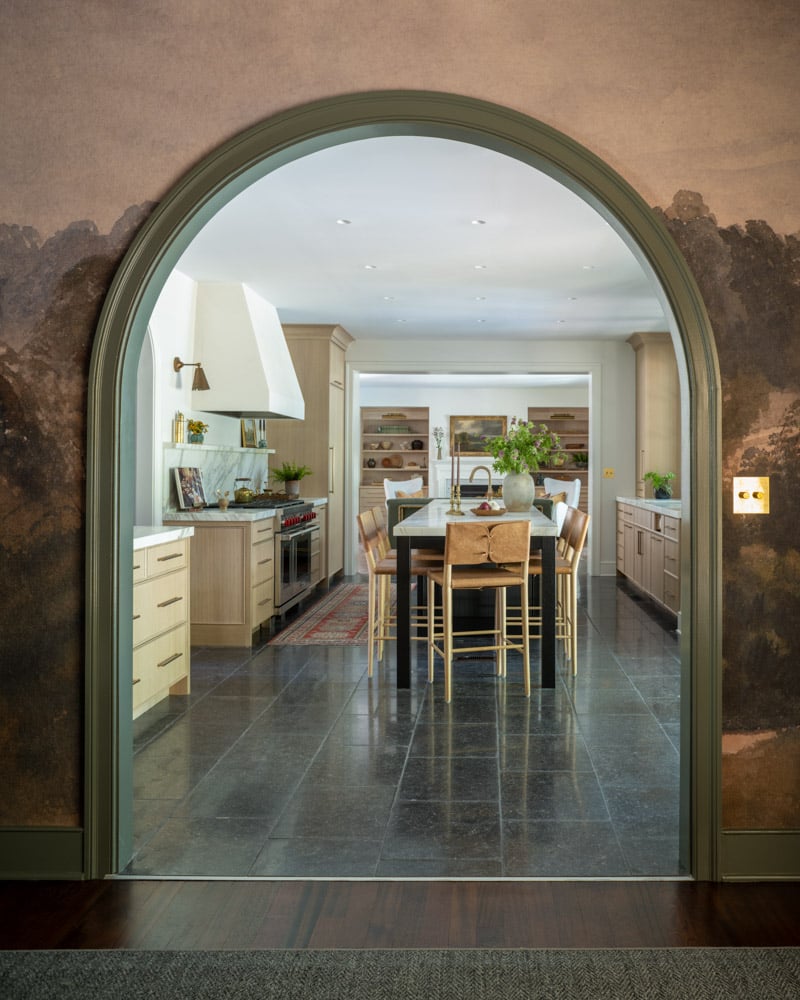
Translating Quiet Luxury Principles to Kitchen Design:
- Simplicity and Balance: Clean lines, uncluttered surfaces, and a harmonious balance of elements are paramount. Visual noise is meticulously banished.
- Functionality First, Elegantly Expressed: Storage is thoughtfully integrated, often concealed. Workflows are optimized for ease of use, embodying functional beauty.
- Natural Materials are Essential: Stone (marble, quartzite, limestone) and wood (oak, walnut, maple) are fundamental, chosen for their tactile qualities and timeless appeal. Artisan-made accessories and beautifully glazed tiles can add subtle layers of detail.
- Muted, Serene Palettes: Soft greys, warm beiges, creamy off-whites, and muted greens or blues create a soothing backdrop.
Custom Cabinetry: The Cornerstone of the Quiet Luxury Kitchen:
Bespoke cabinetry is instrumental in realizing the Quiet Luxury kitchen aesthetic. It allows for the precise execution of clean lines, functional minimalism, and a design tailored specifically to the homeowner’s needs and the architectural integrity of the space.

Hallmarks of Quality in Cabinetry:
- Superior Craftsmanship & Joinery: Look for traditional joinery techniques like dovetail joints in drawers and mortise and tenon construction for frames. These are not just beautiful details but indicators of structural integrity and longevity. Hand-built cabinets by skilled artisans ensure a flawless and premium outcome.
- Solid Construction: Features like half-inch or three-quarter-inch thick side panels, full-height back panels, and robust internal bracing signify well-made, durable cabinetry designed to withstand daily use.
Material Focus for Understated Elegance:
- Woods: Fine woods such as White Oak (often rift-sawn for its straight grain or cerused for texture), Walnut (for its richness), Maple (for its smooth paintability or subtle grain), and Cherry (for its warm patina over time) are prominent. Solid wood is often the “gold standard,” though high-quality veneers are also used skillfully.
- Stone Countertops: Beyond visual appeal, consider the stone’s porosity, maintenance, and how its veining or pattern will interact with the cabinetry and overall design. Honed or leathered finishes are often preferred over high-gloss for a softer, more tactile feel.
Finishing Touches: Nuances in Finishes and Discreet Hardware:
- Cabinet Finishes:
- Matte/Low-Sheen: These are preferred for their subtle elegance, reducing glare and showcasing the cabinet’s form and color.
- Stained Natural Wood: Carefully selected stains can highlight the natural grain and warmth of the wood, offering a timeless, sophisticated feel.
- Hand-Painted: This allows for ultimate customization in color, providing a unique, bespoke character, especially with muted, complex tones.
- Cerused Oak: This traditional technique mutes the wood’s base color while emphasizing the grain with a contrasting pigment (often white or light-colored wax), adding depth and visual interest without being overpowering.
- Hardware: Cabinet hardware is a meticulously selected detail. The trend leans towards hardware that is either a subtle, jewel-like accent or virtually disappears.
- Minimalist Styles: Discreet edge pulls (lip pulls), minimalist T-bars, or small, elegant knobs are favored.
- Integrated/Handle-Free: Push-to-open mechanisms or recessed/channel pulls create a seamless, uninterrupted cabinet surface, epitomizing understated design.
- Material Choices: Brushed gold, matte black, polished nickel, antique brass, or even wood pulls that match the cabinetry contribute to the refined aesthetic.
Beyond the kitchen, these principles of material honesty, tailored design, and meticulous craftsmanship extend to library built-ins, bathroom vanities, dressing rooms, and custom storage solutions throughout the home, creating a cohesive and quietly luxurious environment.
Articulating Value: The Designer’s Dialogue on Quiet Luxury Investments
Successfully guiding clients towards Quiet Luxury often hinges on your ability as a designer to articulate the intrinsic worth of this approach, moving the conversation beyond initial price considerations to an appreciation of its long-term benefits and profound value.
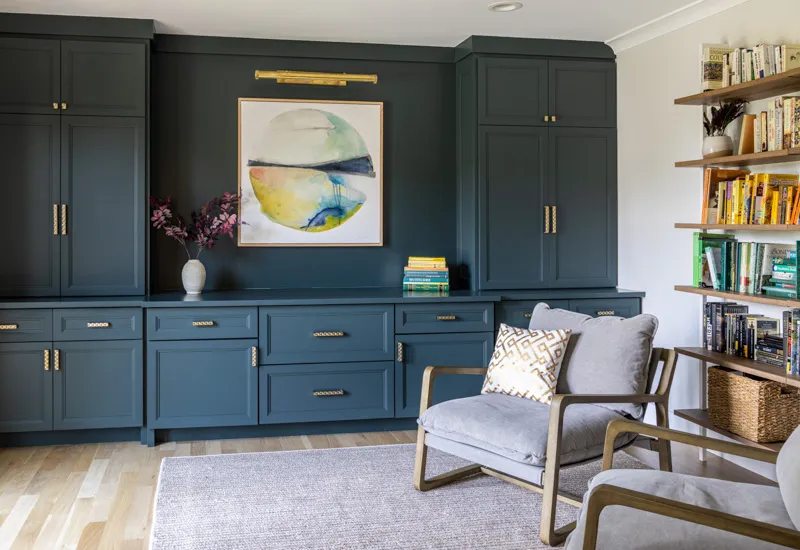
Strategies for Communicating Intrinsic Worth:
- Storytelling: Explain the origin of specific materials, the intricacies of the craftsmanship involved (e.g., the hours to hand-finish a cabinet door), or the historical significance of a particular design element. This creates a deeper connection and appreciation.
- Tangible Experiences: Provide samples of high-quality materials. Encourage clients to touch and feel the difference between standard and premium options. Showcasing examples of fine craftsmanship in a portfolio, showroom, or even a completed project can be very impactful. If you choose to work with Master Design Cabinetry, there is a showroom with many resources to help clients understand and appreciate the material options.
- Focus on the “Why”: It’s an investment in a lifestyle that cherishes quality, mindfulness, and timeless beauty. The “quality of materials, not the quantity, gives pieces their enduring value.”
Highlighting Longevity, Craftsmanship, and Personalization:
- Longevity: Emphasize that timeless designs and durable materials ensure the space will remain stylish and functional for many years, representing better long-term value.
- Craftsmanship: Educate clients on how meticulous craftsmanship contributes not only to aesthetics but also to structural integrity and durability. This is what distinguishes true luxury.
- Personalization: Stress that Quiet Luxury, especially with custom elements, offers the opportunity to create spaces entirely unique to your clients, perfectly aligned with their lifestyle and taste.
Overcoming Client Objections (e.g., “It’s too expensive”):
- Empathy and Transparency: Understand the client’s concerns and budget. Provide comprehensive, itemized quotes that clearly detail costs.
- Explain Your Value: Your pricing structures often reflect established relationships with trusted vendors, access to exclusive items, and comprehensive project management, quality assurance, and logistical coordination that clients cannot achieve alone.
- Focus on Value, Not Just Price: Clearly explain why a particular natural stone, a specific wood species with a complex finish, or bespoke joinery, while potentially more costly upfront, delivers superior aesthetics, enhanced durability, and a unique, intangible feel that less expensive alternatives cannot replicate.
Designers’ role expands to that of an educator and curator, assembling a highly personalized environment that reflects discernment and depth.
The Enduring Horizon for Quiet Luxury
Quiet Luxury is not merely a passing phase but a significant design movement with considerable momentum. Its future trajectory appears robust, deeply intertwined with evolving client desires and societal values.
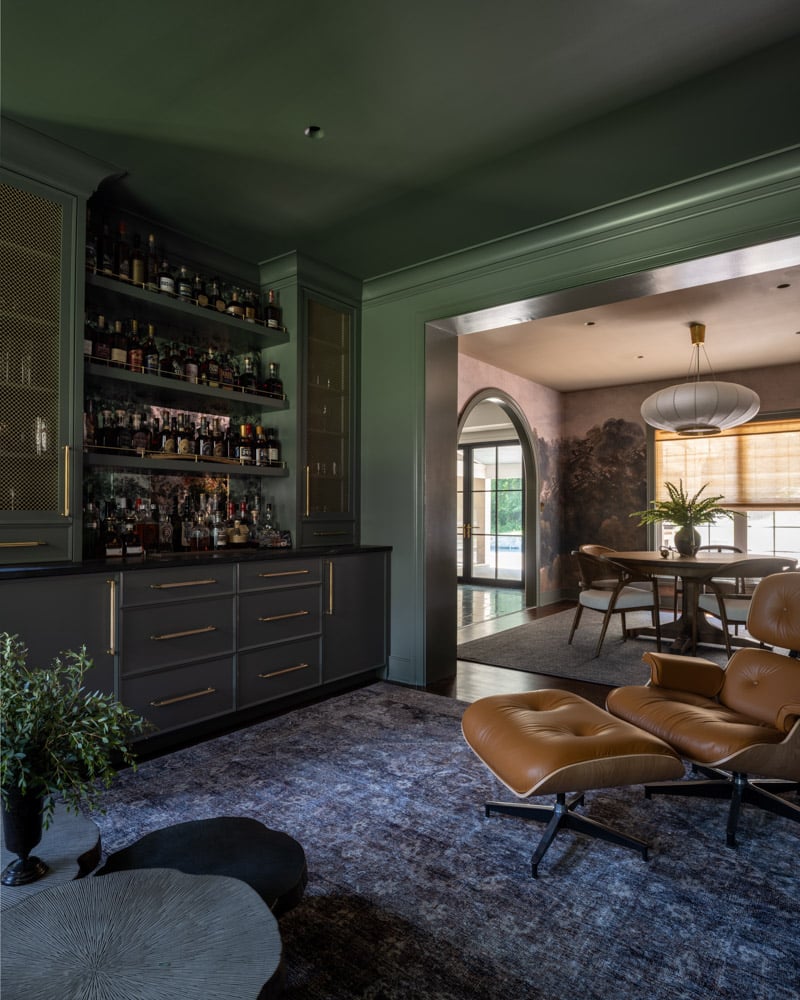
- Market Relevance and Evolution: It reflects a broader societal shift towards “mindful decorating, sustainability, and a focus on quality over quantity.” Its core tenets will endure, though it will likely adapt, perhaps incorporating more organic forms or allowing for more vivid (yet still refined) personal expression to prevent it from becoming a homogenous aesthetic. The “quiet” refers to the absence of ostentation, not the suppression of personality.
- Integration with Well-being, Sustainability, and Technology:
- Designs will increasingly focus on creating “calming, health-focused spaces,” utilizing natural, durable, and ethically sourced materials. Biophilic design principles will remain key.
- Technology (IoT, smart home features) will be integrated subtly and seamlessly, enhancing comfort and convenience without becoming intrusive. The luxury will be in the effortless functionality.
- Evolving Client Desires: Hyper-Personalization and Experiential Luxury:
Clients are increasingly seeking “immersive, personalized, and brand-curated experiences.” There’s a distinct move towards “personalized comfort” and spaces that “truly reflect personal expression.” Quiet Luxury must adapt to this intensified demand, ensuring that each space is not just quietly luxurious but uniquely and profoundly theirs.
Crafting Legacies of Serene Sophistication
Quiet Luxury is more than an aesthetic; it’s a testament to the enduring appeal of authentic quality, meticulous craftsmanship, and thoughtful, personalized design. It’s about creating homes that are not just beautiful, but are deeply personal sanctuaries – spaces that reflect discerning taste, support a considered lifestyle, and offer a sense of calm and refined comfort for generations to come.
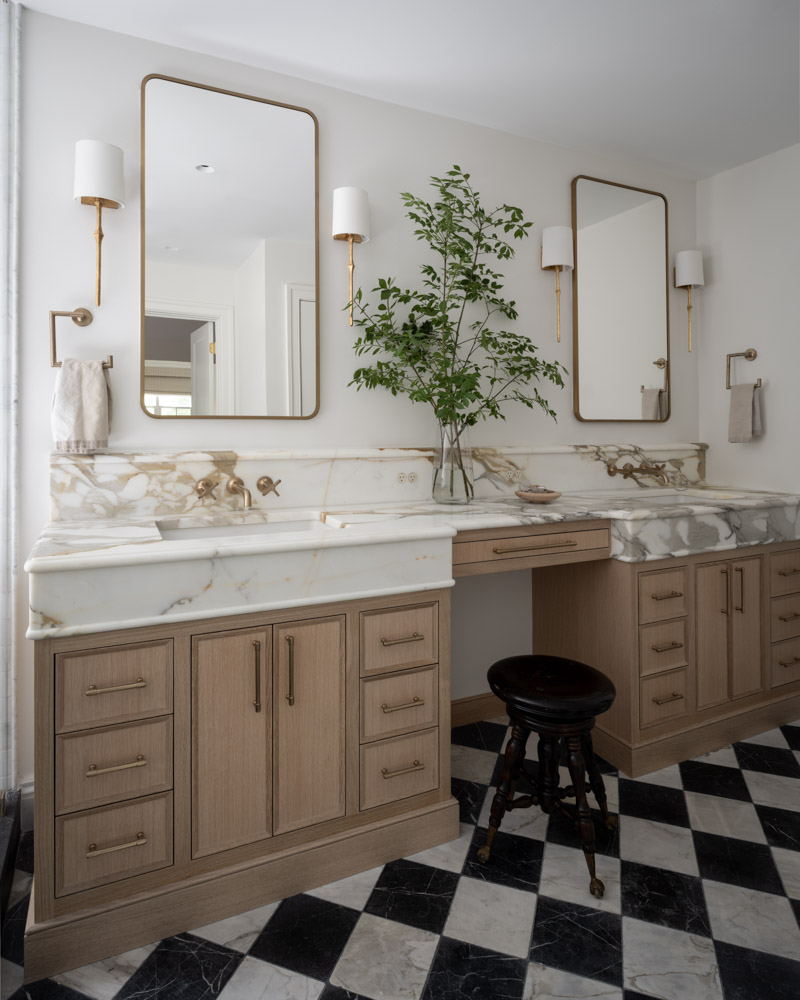
For the interior designer, embracing Quiet Luxury is an invitation to guide clients on a journey towards creating spaces of profound meaning and lasting value. It requires a knowledgeable understanding of materials, a confident approach to design, and a collaborative spirit to translate a client’s deepest aspirations into a tangible reality. By championing the principles of understated elegance and intrinsic worth, you can help craft environments that truly whisper luxury, creating legacies of serene sophistication.
Partner with Master Design Cabinetry
To truly translate the nuanced philosophy of Quiet Luxury into tangible environments, particularly where bespoke cabinetry forms the cornerstone, collaboration with trusted partners is paramount. You will find Master Design Cabinetry, with our specialization in luxury, custom-made cabinetry, offers an aligned vision for you as a designer, architect, builder, or discerning homeowner seeking unparalleled quality and personalization. Drawing from the rich tradition of “authentic homegrown craftsmanship” in Lancaster County, Pennsylvania, Master Design Cabinetry designs, builds, and meticulously installs high-quality custom cabinets for every space within a home, from signature kitchens to serene living areas. Our commitment to “true customization” means that “If you can dream it, we can create it,” focusing on unique features and meticulous details that resonate with the Quiet Luxury ethos.
Master Design Cabinetry’s comprehensive, end-to-end service, coupled with our dedication to meticulous attention to detail and premium materials, ensures an uncompromising commitment to excellence. As mentioned previously, our showroom and discovery room offer invaluable resources for you and your clients to explore and appreciate the material options and the “invisible” value of superior construction. In a shared pursuit of creating legacies of serene sophistication, such partnerships become essential for transforming deeply personal aspirations into enduring architectural realities.


Great, educational article !!!!